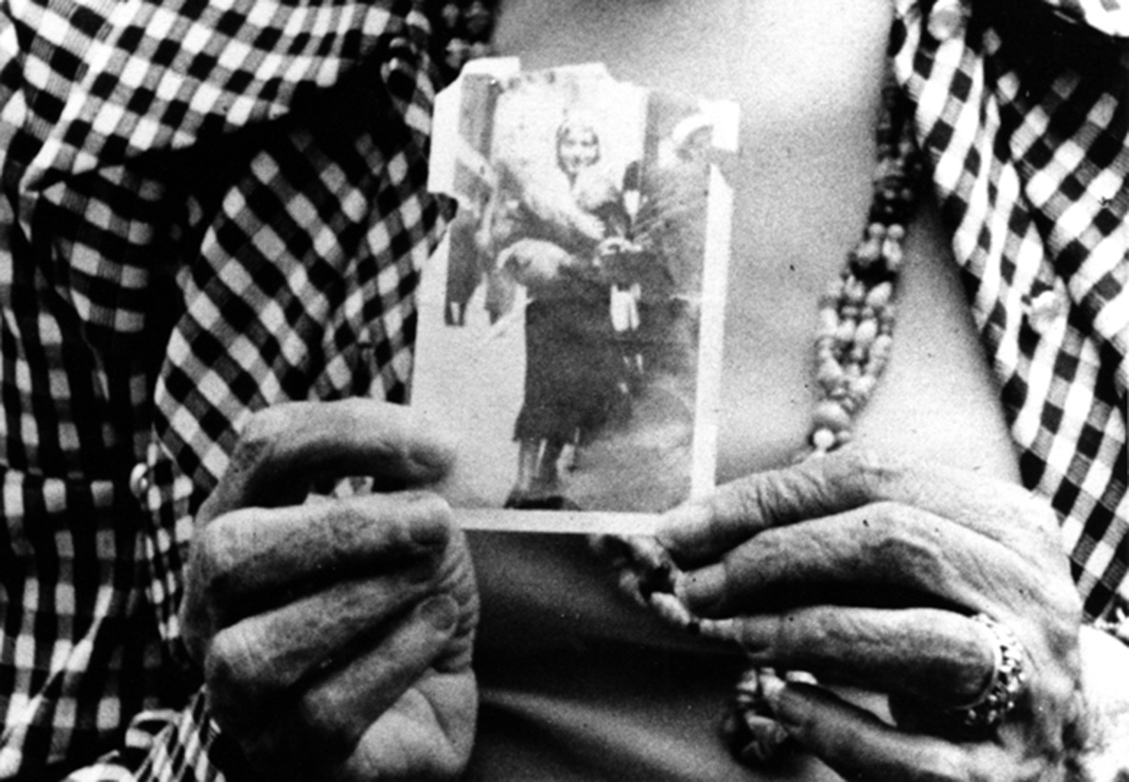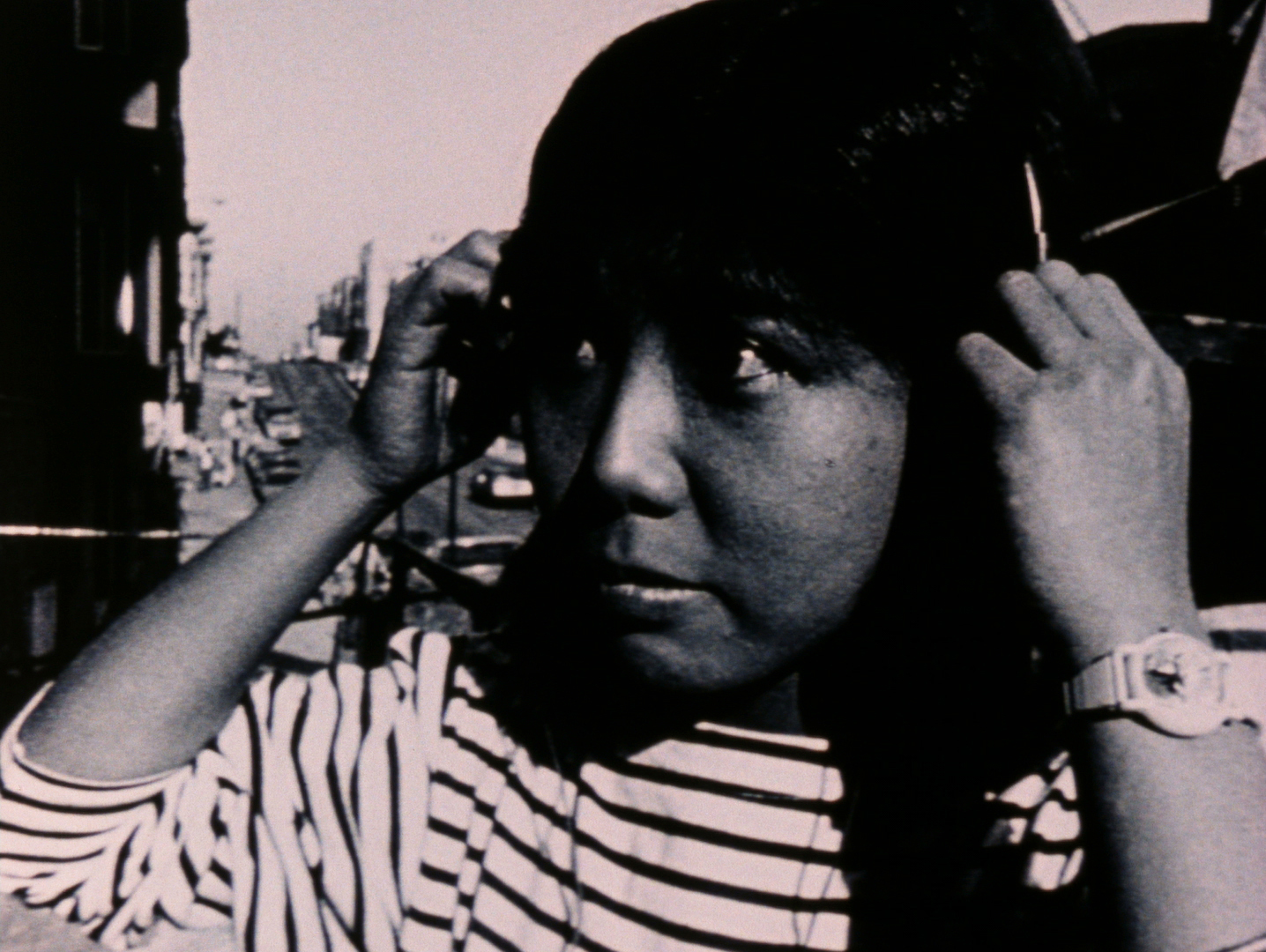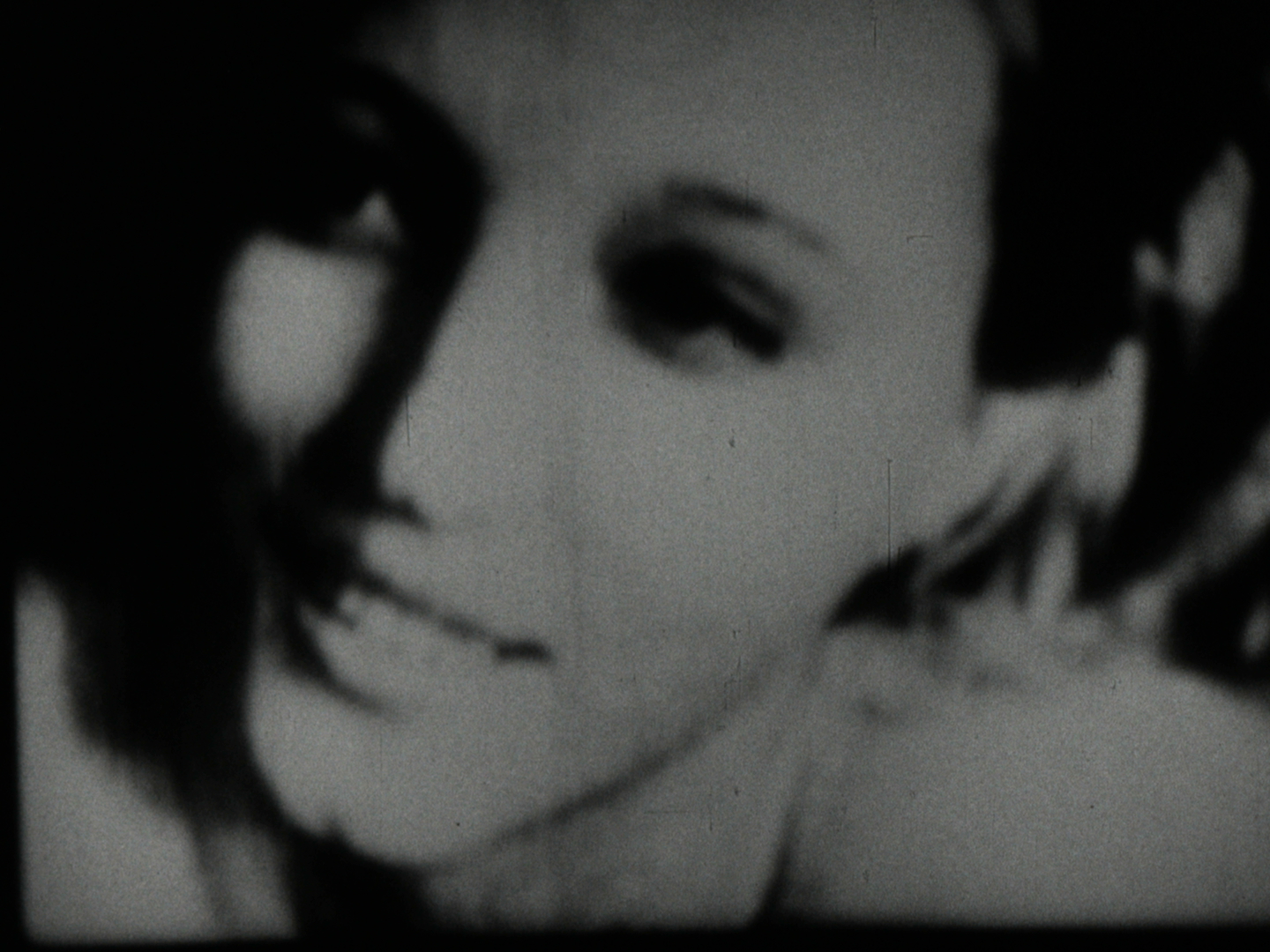
By Tess Takahashi
I came to Canyon Cinema with the project of researching little-seen experimental work by women made on 16mm between the 1960s and the 1980s. Having long wondered how the history of the avant-garde cinema might shift if a different group of filmmakers had been taken up by critics and scholars as the avant-garde “canon” was beginning to form, I meandered—with expert guidance and support from Canyon’s lovely staff and volunteers—through Canyon’s collection searching for overlooked gems by women, queer filmmakers, and people of color. This short essay surveys the work of six women filmmakers featured in the Canyon Cinema 50 touring programs. While experimental film enthusiasts likely know many of these names, their individual oeuvres are full of surprising works that we’ve all been missing out on.
Sara Kathryn Arledge’s stunning—and diverse—body of films span from the early 1940s to the 1980s. What is a Man? (1958), featured in the Canyon Cinema 50 Touring Program 2, is a tour de force said to have been made after the artist spent some time in a mental asylum. The film is structured as a series of absurdist vignettes between a woman and a car salesman, her psychiatrist, and her lover, in which double entendres produce a farcical critique of gender relations. Sharing an affinity with Owen Land’s On the Marriage Broker’s Joke… (1979), What is a Man? and Arledge’s What Do Two Rights Make? (1983) employ short skits and biting word play to comment on cultural mores. Arledge’s body of work also includes formalist and painterly abstraction, as in Introspection (1941), a beautiful, prismatic film featuring three male dancers, whose solarized forms are layered and manipulated through optical printing (the result gives Maya Deren a run for her money). Arledge also made a number of abstract, jewel-like films based on her translucent painted color slides, many of which are held by the Berkeley Art Museum and Pacific Film Archive. These include Tender Images (1978) and Interior Garden (1978), films that evoke Brakhage’s later hand-painted works.
Betzy Bromberg’s Ciao Bella, or Fuck Me Dead (1978) is a classic, bad-ass girl motorcycle extravaganza included in Canyon 50 Touring Program 1. It’s also perhaps her most screened film, but Bromberg’s other works at Canyon are a revelation. Soothing the Bruise (1980) is an associative weave of bright colors, beautiful girls, and everyday scenes juxtaposed with an allusive soundtrack (and striking final titles) that evokes the political, cultural, environmental, and gendered implications of ordinary conversation. Marasmus (1981), Bromberg’s collaboration with Laura Ewig is likewise beautifully shot in sumptuous color and layered with masterful optical printing. Described by Janice Crystal Lipzin as “full of seductive glamour,” Marasmus overlays a cis woman with a trans woman in full make-up, scarves, and glittery outfits pictured in a mirrored room, in the desert, and in the mountains. The film’s complex, essayistic amalgam of sound and voice, the poetic and political, is never didactic or heavy-handed. Canyon has a ton of Bromberg’s other, under-screened 16mm titles as well, including Petite Mal (1977), Az Iz (1983), The Body Politic (1988), Divinity Gratis (1996), and A Darkness Swallowed (2005).
Chicago-based artist Jean Sousa’s films are formally rigorous, sensually present, and always inventive in their explorations of different cinematic properties. Swish (1982), in Canyon 50 Touring Program 1, is a silent investigation of the medium’s relationship to motion, offering occasional, swishing glimpses of a young Sousa as she dances with her moving camera, her face close to the camera’s open shutter. Ellen on the Rope (1978) features multiple takes of the eponymous Ellen swinging back and forth across the length of a nearly empty loft apartment. The two artists, filmmaker and performer, work together to produce “a strobing rhythm by crossing the camera’s shutter speed with the rate of the rope traversing its frame,” in the words of B. Ruby Rich. Sousa’s The Circus (1977) is a colourful and elaborate optically printed film that edges its depictions of circus performers closer and closer to the bright abstraction of moving shapes and colors. Also check out Sousa’s Summer Medley (1977), What Am I Doing Here (1978), Spent Moments (1984), and Today is Sunday (1987). Her mix of structural and somatic investigation gives structural film a completely different feel.
Similarly, JoAnn Elam’s Lie Back and Enjoy It (1982), featured in Canyon 50 Touring Program 3 and Digital Program 1, is a knockout that mixes the structural, the critical, and the sensuous. I imagined a more didactic piece, which, as Claudia Gorbman writes, “examines the politics of filmic representation of women under patriarchy.” What I found instead was a fascinating combination of a visually pleasurable image, as the film’s close-up of a woman’s face is optically printed and transformed over the course of the film, juxtaposed against audio of a conversation between a male filmmaker and his intended female subject as she jokingly shows him that his simple desire “to make art” and to “tell the truth” is anything but simple. This is a sharp, funny, aesthetically compelling film that should have been an instant classic. It not only has the power to surprise veterans of the avant-garde film scene but also could be valuable in an intro film course. Elam’s other film in Canyon’s collection, Rape (1975), an explicitly feminist documentary that captures a group of women as they speak frankly about their personal experiences with rape, is very different in tone, and would be a particularly provocative historical document to screen in the #MeToo era. Check out Chicago Filmmakers for Elam’s other titles.
Greta Snider might be the punk inheritor of Robert Frank and Alfred Leslie’s Pull My Daisy (1959). I was most familiar with works like Quarry Movie (1999), her environmentally-minded collaboration with a number of other filmmakers to “document a place – not only its image as lensed, but its weather, its soil, and its toxins,” in Snider’s words. However, I was bowled over by the vigor and exuberance of her earlier work: their black-and-white images can be rough and grainy, but their structure is both formally precise and playfully engaging. Snider’s Portland (1996), which is part of Canyon 50 Touring Program 1, was one such revelation, with its charismatic characters (Snider’s friends), interwoven narrative, smart reflexive points, and youthful joie de vivre. It would be great for teaching an intro film class about narrative construction. Similarly, Hard Core Home Movie (1989) feels like a commentary on the semiotics of authenticity with its carefully constructed, quasi-anthropological assortment of punk kids, middle-aged tourists, and passers-by espousing their thoughts about what it means to be “hard core.” Canyon has a trove of Snider’s films on 16mm, including Futility (1989), Blood Story (1990), Mute (1991), Our Gay Brothers (1993), No Zone (1993), Flight (1996), Urine Man (2000), and The Magic of Radio (2001).
Finally, Cauleen Smith’s Chronicles of a Lying Spirit (by Kelly Gabron) (1992) should take its place alongside works like Trinh T. Minh-ha’s Reassemblage (1982) and Rea Tajiri’s History and Memory (1991). While Smith has made many, many films integrating disparate genres, forms, and technologies, Chronicles of a Lying Spirit (By Kelly Gabron) feels like a real find. It explores questions of race, history, gender, autobiography, documentary, and art-making practice through formal experimentation with layered images and a dense mix of voices. Smith takes the viewer through the same material twice, a journey that results in very different readings, before leading into a revelatory final sequence. This film makes me eager to explore Smith’s larger oeuvre.
So, then, to return to my opening question, what kind of avant-garde canon might we have if we looked more broadly across the body of films being made in that period – and deeper into the work of individual filmmakers? Perhaps not unexpectedly, the work of many women filmmakers between the 1950s through the late 1980s raises questions of film’s identity as a medium as it overlaps with questions of personal, political, gendered, and embodied identity. As in the experimental videos concerning identity politics produced in the 1980s and 1990s, some of this work might have been seen as edging into the realm of documentary despite a characteristically “avant-garde” attention to questions of form and medium. This essay only scratches the surface of Canyon Cinema’s rich holdings, but I hope it suggests some of the joys and revelations that digging beyond the usual suspects can hold for programmers, teachers, and curators. We should remember that canons are porous, contingent, and ever-shifting – produced in part by circumstance, geography, friend groups, and other vagaries of history. Established canons may be full of amazing works, but they ought to be questioned, argued over, and shaken up. In addition to the filmmakers noted above, the programs in the Canyon Cinema 50 Tour include great works by a number of other women filmmakers including Stephanie Barber, Abigail Child, Mariah Garnett, Janie Geiser, Barbara Hammer, Karen Holmes, Julie Murray, Gunvor Nelson, Charlotte Pryce, Emily Richardson, Chick Strand, and Naomi Uman that will shift your sense of the history of avant-garde film.
Tess Takahashi is a Toronto-based scholar, writer, and programmer who focuses on experimental moving image arts. She is currently working on two book projects, Impure Film: Medium Specificity and the North American Avant-Garde (1968-2008), which examines artists’ work with historically new media, and On Magnitude, which considers contemporary artists’ work against the backdrop of Big Data and data visualization. Takahashi has been scholar-in-residence at the Film-Makers’ Co-op in New York City (2015), at Canyon Cinema in San Francisco (2016-17), and the Canadian Filmmakers’ Distribution Center in Toronto (2017-8). She is a member of the experimental media programming collective Ad Hoc and the editorial collective for Camera Obscura: Feminism, Culture, and Media. Takahashi’s writing has been published there as well as in Cinema Journal, the Millennium Film Journal, Animation, MIRAGE, and Cinema Scope.
The Damage Done

By Holly Willis
How long was I angry? Definitely all the way through the ’80s. There were a dozen good reasons why, and at least as many stabs at getting around that anger: drinking, prowling through the night, writing, or trying to write, and generally making a mess of things. It took a spate of films and videos by women to loosen things up, to make me even begin to feel something like whole again. Films by Su Friedrich and Barbara Hammer, videos by Joan Jonas, Lynn Hershman, and, a little later, Sadie Benning. And it was not simply stories by women for women. It was the way they were made, the scratching, scraping, scarring. The wrenching, the cutting and re-cutting, the stealing, pirating, pillaging.
It was the violence enacted on the medium itself that I loved.
Rather than fetishizing the polish of Hollywood or emulating the high sheen of video art’s mostly male canon, these works literally trash the medium they were composed within, scratching emulsion, distorting the image, wrecking the sound. Not interested in the intellectual juxtapositions of so much of the collage and montage of a broader avant-garde heritage, this work is adamantly political, fashioning scruffy, defiantly bedraggled imagery into biting commentary in and through a literal destruction and mangling of the moving image. Scratch, rip, destroy!
Take Naomi Uman’s short film Removed (1999). The filmmaker appropriated several sections of a 1970s porn film with a patently ridiculous plot: two couples fool around in two hotel rooms, which are connected by a two-way mirror. In room one, the man and woman argue, undress and have sex. In room two, the man narrates the action happening next door for his partner while pawing at her body. She twists and turns and, through gasps, asks for more details. “She’s studying her body,” her partner drolly reports, and indeed she is. And so are a bunch of us. Or we are trying to.
You see, Uman applied acetone to the emulsion, working frame by frame to etch out the writhing bodies of every woman in the film. All that remains are moaning white splotches. On occasion, there’s the flash of a nipple or an expression on a face where the bleach or nail polish missed their mark, but rather than titillating, the revelation underscores the flatness of the original, its utter banality. In contrast, the wiggly amorphous shapes shiver and shimmy defiantly, and we regard with gleeful satisfaction the damage done.
In Removed, we also contemplate Uman’s physical labor. It is impossible not to imagine her hands painstakingly doing their work, tangibly changing the texture and chemical composition of the image. Frame by frame, erasing, dissolving away the body. In her hands, the bleach becomes an unlikely salve for an enduring anger.
In a similar vein, JoAnn Elam inflicts her own kind of damage upon a piece of footage, making it vibrate with an uncomfortable flicker. Her film Lie Back and Enjoy It (1982) pairs a conversation on the soundtrack between a man and a woman discussing gender and power with black-and-white images of a woman’s face, shot from just slightly above. She looks sexy. There’s something going on, but you’re not quite sure what. In the verbal exchange, the woman argues, “You are trying to establish a power relationship here by filming and taping me,” and meanwhile, we watch the other woman onscreen, very much an object within a power dynamic. She performs a sense of pleasure, smiling coyly. In the audio conversation, the man objects to his partner’s accusation, explaining that he is merely trying to get to the truth. “I have a camera and you don’t,” he says matter-of-factly, and it is as if this simple truth is enough to stop the conversation.
It does not stop the conversation, however. Elam lets the arguing pair bounce back and forth as they try to parse how power is embedded in the image while we see evidence of that power through the way the woman onscreen is framed. Elam messes with the image, using a strobing effect, inserting intriguing intertitles and showing sprocket holes. There is no way to forget that we are watching a film as it becomes nearly uncomfortable to focus on the woman’s face through the flashing. And yet the power of the imagery is tremendous, and the pleasure in seeing her is unmistakable. Like Removed, this is a brilliant project that makes its point through a violent dismantling and disruption.
Rather than marring the emulsion or stuttering her images, Betzy Bromberg’s tactic in her 1978 film Ciao Bella is to fold things together, blending the act of filmmaking and the body such that the film becomes a means for knowing who you are in the work that you create. The film is set in the streets and interior spaces of 1970s New York, and Bromberg juxtaposes snippets of childish energy and the provocation of nearly naked women. She deftly contrasts vibrant exuberance with a sense of devastating loss, and the effect is at once brazenly personal and deeply political. One of the final shots of Ciao Bella is of a jubilant topless dancer caught in a reddish flare and sprocket holes; the picture merges the woman’s vivacious energy with film as a medium, and this is a perfect emblem for Bromberg’s work, which so often attends to the specific beauty and potential of film.
If folding names Bromberg’s tactic, for Abigail Child it’s collision that perhaps best describes her approach in the film Mercy (1989). While reminiscent of Bruce Conner’s A Movie (1958) in the sweep of found footage images that bang and clash, Child’s film goes straight for the body. Kneading hands, pulsing biceps, bare breasts, coiffed hair: you can feel these bodies. At the same time, the bodies are forced into highly coded cultural practices – wrestling, taking pictures, waterskiing, marching in parades – or they try to find a way to be at home in curiously regimented spaces, such as the assembly line and amusement park. The bodies reckon with regimes of authority, even if these are conspicuously ridiculous enactments of that authority.
With her 1992 film Chronicles of a Lying Spirit (by Kelly Gabron), filmmaker Cauleen Smith similarly skewers authority with an unorthodox autobiographical collage driven by an almost incantatory voice describing life events that cannot possibly pertain to a single person. In this way, the film cheerfully disrupts the unified self of Western philosophy, replacing the “I” with a chorus of voices and a collage of cut-out imagery and type-written texts. Together, these fragments of many lives weave a biography in flux across time and, perhaps most significantly, in relation to those who have come before the narrator, refusing clarity and coherence in favor of layering, doubling and mutability. It’s a struggle to keep up with the panoply of voices here, to make sense, to suss out the truth in the midst of the contradictions, and that’s the point: this is the celebratory and iconoclastic chronicle of a lying spirit.
Lying may or may not be an element in Greta Snider’s black-and-white short film Portland (1996), which tells the story of a group of friends who travel to Portland, Oregon, and endure a series of misadventures. It rains. They’re hungry. Their stuff gets locked up. One of them gets arrested and put on a work crew. Worst of all, a trip dedicated to drinking and partying includes no drinking or partying. The film is funny and raucous, with a kick-ass soundtrack. But what makes it for me is what I love about Snider’s work in general: an unlikely lyricism seeps through here and there. The camera swings out over the railway tracks, for example, and the lines slip into pure form for a moment. Or a door opens, blasting light and blowing the image into abstraction, a dazzle of glistening grey shapes. Or even just the narrow passage between two train cars, when the vertical and horizontal lines and the dark planes of each panel become momentarily a lovely composition in spite of the frenzy. These moments pop up in the midst of the general chaos wrought by a camera moving unapologetically with a body that’s relentlessly roaming around to see what’s what. There is no hallowed respect for the steadiness of proper cinema, and the framing is careless in the best sense. This is irreverence embodied, and that fierce defiance makes my heart sing.
The material destruction enacted by these artists shuffles notions of aesthetic value, refusing the hierarchy of polish. Better than that, the damage done to the image and sound is visceral. Each scratch, each blur, each flicker: we feel it and it feels damn good.
Holly Willis is a Research Professor in the School of Cinematic Arts at the University of Southern California. She is the author of Fast Forward: The Future(s) of the Cinematic Arts and New Digital Cinema: Reinventing the Moving Image, as well the editor of The New Ecology of Things, a collection of essays about ubiquitous computing. She is also the co-founder of Filmmaker Magazine dedicated to independent film and she writes frequently for diverse publications about experimental film, video and new media.



